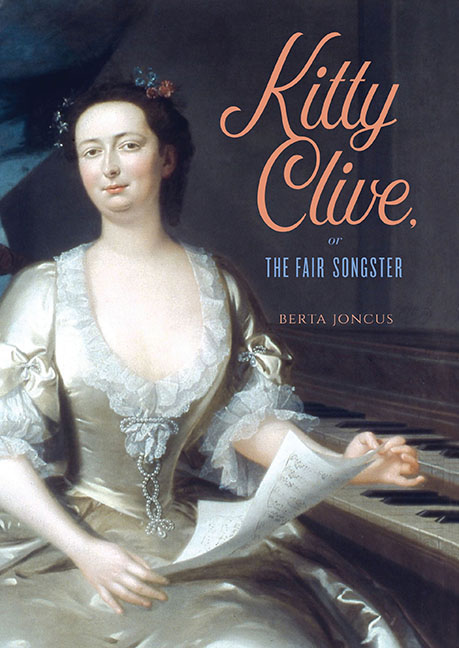Book contents
- Frontmatter
- Dedication
- Contents
- Illustrations
- Preface
- Conventions of Transcription
- 1 The Siren Song: Kitty Clive in the Playhouse
- 2 ‘The Lovely Virgin tun'd her Voice’: Henry Carey and the Production of a Native Songster
- 3 ‘Charm'd with the sprightly Innocence of Nell’: The Metamorphosis of Miss Raftor
- 4 ‘HINT writes, and RAFTOR acts in Drury-lane’: Clive, Fielding, and Theophilus Cibber
- 5 ‘The pious Daughter, and the faithful Wife’: Fielding, Miller, and Clive, 1733–35
- 6 ‘A Likeness where none was to be found’: Contested Images of Clive, 1734–37
- 7 The Patriot Soprano: British Worthies at Drury Lane
- 8 Handel and the Sweet Bird of Drury Lane, 1740–43
- 9 The Case of Mrs. Clive
- 10 Of Scuffles and Rivalries: The Demise of ‘Kitty Cuckoe’
- 11 From Miss Lucy to Mrs. Riot: Voice and Caricature
- 12 Clive on Clive: The Rehearsal: Or, Bays in Petticoats
- 13 Conclusion: The Fair Songster
- Appendix 1 Catherine Clive's Roles 1728–69
- Appendix 2 Lines in Catherine Clive's Repertory 1728–69
- Appendix 3 The Case of Mrs. CLIVE (1744)
- Select Bibliography
- Index
6 - ‘A Likeness where none was to be found’: Contested Images of Clive, 1734–37
Published online by Cambridge University Press: 20 September 2019
- Frontmatter
- Dedication
- Contents
- Illustrations
- Preface
- Conventions of Transcription
- 1 The Siren Song: Kitty Clive in the Playhouse
- 2 ‘The Lovely Virgin tun'd her Voice’: Henry Carey and the Production of a Native Songster
- 3 ‘Charm'd with the sprightly Innocence of Nell’: The Metamorphosis of Miss Raftor
- 4 ‘HINT writes, and RAFTOR acts in Drury-lane’: Clive, Fielding, and Theophilus Cibber
- 5 ‘The pious Daughter, and the faithful Wife’: Fielding, Miller, and Clive, 1733–35
- 6 ‘A Likeness where none was to be found’: Contested Images of Clive, 1734–37
- 7 The Patriot Soprano: British Worthies at Drury Lane
- 8 Handel and the Sweet Bird of Drury Lane, 1740–43
- 9 The Case of Mrs. Clive
- 10 Of Scuffles and Rivalries: The Demise of ‘Kitty Cuckoe’
- 11 From Miss Lucy to Mrs. Riot: Voice and Caricature
- 12 Clive on Clive: The Rehearsal: Or, Bays in Petticoats
- 13 Conclusion: The Fair Songster
- Appendix 1 Catherine Clive's Roles 1728–69
- Appendix 2 Lines in Catherine Clive's Repertory 1728–69
- Appendix 3 The Case of Mrs. CLIVE (1744)
- Select Bibliography
- Index
Summary
Clive's likeness and its parts – picturing Orphic powers – the Cibbers and Thomas Arne at Drury Lane – Phaeton falls and Clive rises – rival Pollies and Clive's victory – a truce between the Tragedy Queen and the Comic Muse
After the squabbles and publicity of the 1733–34 season, Clive's likeness became more briskly traded. Drury Lane management may well have been behind this business, for just as Clive began taking over more of Anne Oldfield's comic parts, portraitists were mapping Oldfield's body onto hers. Chance now threw more Oldfield parts into her lap: her three main rivals, Hester Booth, Christiana Horton, and Mary Heron, all disappeared from the scene. Booth, née Santlow, retired after selling her husband's patent share in September 1733. Horton, who had joined Theophilus Cibber's rebel company, crossed over to Covent Garden in September 1734 rather than return to Drury Lane. And in May 1735 Heron, dubbed in 1733 ‘the Inheritrix of Oldfield's Fame’, had a stage accident that forced her retirement. Further strengthening Clive's position, soon after March 1734 Fleetwood ‘displaced’ Cibber as deputy manager with someone she had no quarrels with, the Irish comic actor Charles Macklin. Brought in by John Highmore to replace actors absent during the revolt, Macklin had created ‘the Drunken Colonel’ in The Intriguing Chambermaid, stamping this work with his craft as Clive had with hers. When, from January 1736, four more of Oldfield's comic roles fell to Clive over the next two seasons, the casting may well have been Macklin's. As Clive appropriated Oldfield's roles, three different portraits of her appeared, all of which evoked Oldfield's person.
The portraitists faced a serious challenge. A plain woman, Clive bore as little resemblance to Oldfield as she had to Godfried Schalcken's seventeenthcentury shepherdess of the 1729 ‘Miss Rafter’ mezzotint. The truest of Clive's new likenesses, a mezzotint portrait of 1734, drew sharp criticism for being unflattering.
- Type
- Chapter
- Information
- Kitty Clive, or the Fair Songster , pp. 168 - 193Publisher: Boydell & BrewerPrint publication year: 2019



